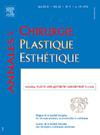Percutaneous approach for inframammary fold creation combined with exclusive adipose tissue transfer in post-mastectomy breast reconstruction
IF 0.5
4区 医学
Q4 SURGERY
引用次数: 0
Abstract
Introduction
The inframammary fold has an important role in breast's aesthetic and maintain and should be restored during breast reconstruction after mastectomy. Several techniques have been described, mainly based on an open approach, not adapted in case of complete reconstruction by fat grafting. To address these concerns, the authors propose a percutaneous approach for inframammary fold reconstruction.
Methods
This single-center, retrospective cohort study included female patients ≥ 18 years old with a history of unilateral or bilateral mastectomy and deferred breast reconstruction using fat grafting with percutaneous inframammary fold creation. Patient data (age, BMI, prior radiotherapy, procedure details, complications) were collected. The percutaneous inframammary fold fixation combines a superficial liposuction of the lower thoracoabdominal area with a percutaneous overlock suture anchoring the dermis to the deep thoracic fascia, and a net suture in segment 4. This technique allows for moderate skin recruitment, simultaneous fat transfers in the same operation, and increase inframammary fold definition and breast ptosis.
Results
A total of 26 patients (29 breast reconstructions) were included. The median age was 59 years, and patients underwent a median of 4 interventions with a total fat transfer volume of 1190 mL. Six patients required IMF revisions, with no major complications observed. The technique showed favorable outcomes with stable IMF definition over time.
Conclusion
This percutaneous inframammary fold creation technique, combined with fat grafting, broadens reconstructive options for mastectomy patients. It is safe, reproducible, and enhances breast aesthetics with minimal morbidity.
Introduction
Le sillon sous-mammaire joue un rôle essentiel dans l’esthétique et la forme du sein et doit être restauré lors de la reconstructions mammaire après mastectomie. Plusieurs techniques ont été décrites, principalement avec une approche ouverte, qui ne conviennent pas en cas de reconstruction complète par transfert de tissu adipeux. Pour répondre à cette problématique, les auteurs proposent une approche percutanée pour la reconstruction du sillon sous-mammaire.
Méthodes
Cette étude de cohorte rétrospective monocentrique inclut des patientes âgées de ≥ 18 ans, présentant des antécédents de mastectomie unilatérale ou bilatérale, et ayant bénéficié d’une reconstruction mammaire différée par transfert de tissu adipeux avec fixation percutanée du sillon sous-mammaire. Les données comprenaient l’âge, l’IMC, l’antécédent de radiothérapie, détails des interventions et complications. La fixation percutanée du sillon sous-mammaire combine une liposuccion superficielle de la zone thoracoabdominale inférieure, un surjet percutané ancrant le derme au fascia thoracique profond, ainsi qu’une suture en filet au niveau du segment 4.
Résultats
Un total de 26 patientes (29 reconstructions mammaires) ont été inclues. L’âge médian était de 59 ans, avec une médiane de 4 interventions par patiente et un volume total moyen de graisse transférée de 1190 mL. Six patientes ont nécessité une révision du sillon sous-mammaire, sans complication majeure observée.
Conclusion
La technique de création percutanée du sillon sous-mammaire, combinée au lipofilling, élargit les options de reconstructions pour les patientes ayant subi une mastectomie. Elle est sûre et reproductible.
经皮入路在乳房切除术后乳房重建中的乳下褶皱形成联合脂肪组织转移。
简介:乳下褶皱对乳房的美观和维护有重要作用,在乳房切除术后重建时应予以修复。已经描述了几种技术,主要基于开放入路,不适合通过脂肪移植完全重建的情况。为了解决这些问题,作者提出了经皮乳房下襞重建的方法。方法:这项单中心、回顾性队列研究纳入了年龄≥18岁的女性患者,均有单侧或双侧乳房切除术和经皮乳房下褶脂肪移植术延迟乳房重建的病史。收集患者资料(年龄、BMI、既往放疗、手术细节、并发症)。经皮乳下褶皱固定包括胸腹下部浅表吸脂术,经皮将真皮固定在深胸筋膜上,并在第4节段进行网状缝合。这项技术允许适度的皮肤恢复,同时在同一手术中脂肪转移,并增加乳房下褶皱的清晰度和乳房下垂。结果:共纳入26例患者(29例)。中位年龄为59岁,患者接受了中位4次干预,总脂肪转移量为1190mL。6例患者需要IMF修订,未观察到重大并发症。随着时间的推移,该技术在稳定的IMF定义下显示出良好的结果。结论:这种经皮乳下褶皱形成技术,结合脂肪移植,拓宽了乳房切除术患者的重建选择。它是安全的,可重复的,以最小的发病率提高乳房美观。
本文章由计算机程序翻译,如有差异,请以英文原文为准。
求助全文
约1分钟内获得全文
求助全文
来源期刊
CiteScore
1.00
自引率
0.00%
发文量
86
审稿时长
44 days
期刊介绍:
Qu''elle soit réparatrice après un traumatisme, pratiquée à la suite d''une malformation ou motivée par la gêne psychologique dans la vie du patient, la chirurgie plastique et esthétique touche toutes les parties du corps humain et concerne une large communauté de chirurgiens spécialisés.
Organe de la Société française de chirurgie plastique reconstructrice et esthétique, la revue publie 6 fois par an des éditoriaux, des mémoires originaux, des notes techniques, des faits cliniques, des actualités chirurgicales, des revues générales, des notes brèves, des lettres à la rédaction.
Sont également présentés des analyses d''articles et d''ouvrages, des comptes rendus de colloques, des informations professionnelles et un agenda des manifestations de la spécialité.

 求助内容:
求助内容: 应助结果提醒方式:
应助结果提醒方式:


